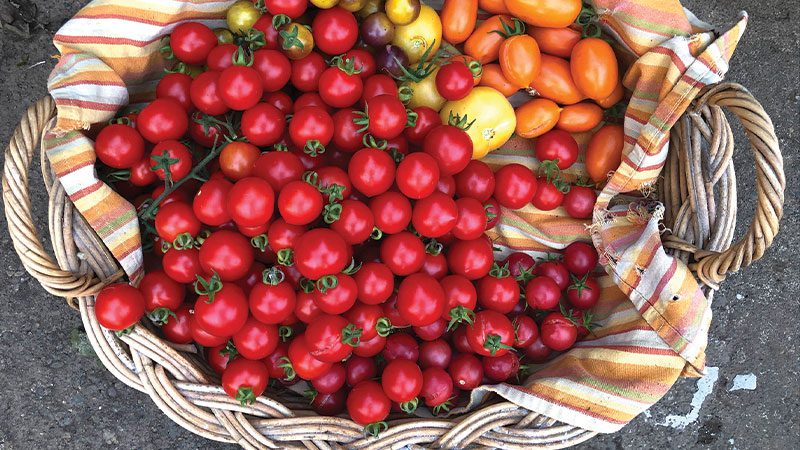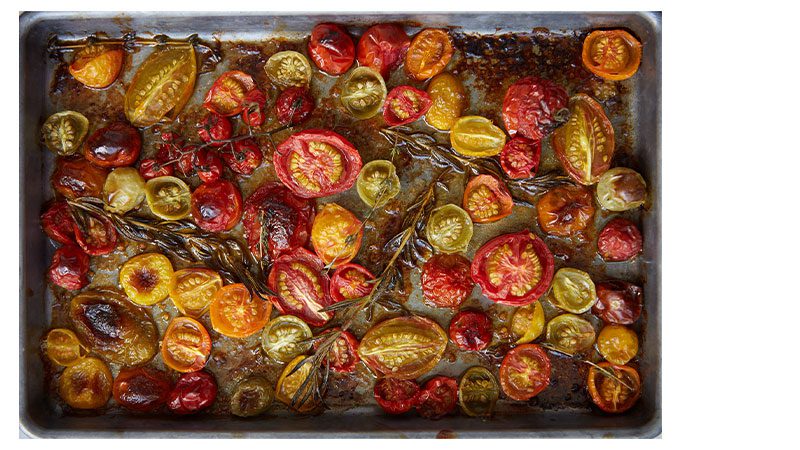Tomato triage: How to use too many tomatoes all year long
By Martha Holmberg, guest contributor
This article was originally published in September 2023

You’ve been patient. You waded through stacks of catalogs to select the perfect varieties for your microclimate. You nurtured seedlings, waited for the soil to warm and the rains to cease (well, maybe not that part), and finally planted tomatoes in the garden. Then came watering, feeding, pruning, sucker-snapping, slug-smushing, until finally—your first ripe tomato!
And then your second, your third, and before you know it, it’s September—peak tomato season in the Northwest. Your vines are laden and you’re harvesting pounds of ripe tomatoes every day.
A tomato lover’s dream come true, right? Well, kinda.
I was overwhelmed for my early years of tomato-growing, and I’ll confess to wasting way too many tomatoes by not dealing with them until all they were good for was the compost pile.
Now, however, I am wiser and I am strategic. When I harvest tomatoes I perform a triage, sorting them on the kitchen counter into three groups: the Eat Nows, the Roasts, and the Freeze for Laters. This small amount of processing work yields tomato goodness throughout the year.
And this system works even if you haven’t grown your own but have come home from the market with a flat or two of peak-season beauties, wondering “what have I done?”
I’m happy to share my system so you can enjoy every single tomato for now and for months to come.
The Eat-Nows
As with any in-season fruit or vegetable, you eat a lot of it when you have it. A pound or two of just-picked tomatoes can be tagged for immediate consumption, to be kept…where?
The counter is fine if your kitchen is cool, but many Northwest houses don’t have central air conditioning, and especially when you’re cooking a lot, the kitchen can get warm, which hastens the decline of a fresh tomato as well as encourages the dreaded halo of fruit flies that emerges from…where, exactly? Ugh.
So counter storage isn’t ideal, but conventional wisdom holds that putting a tomato in the refrigerator is a crime against gastronomy and will mute the delicious flavor nuances. Fortunately, this isn’t quite true.
It turns out that cold’s dampening effect on the flavor compounds in a tomato doesn’t kick in for several days, so I say refrigeration is safe for two or three days. I do recommend letting a chilled tomato warm up a bit at room temp before serving it, as most food tastes better when neither too hot nor too cold.
Here are some Eat-Now ideas for enjoying those tomatoes while they’re in their fresh, raw, ripe glory:
Slice them thick (I think ½ inch is good) to appreciate their succulent texture. Dress with flaky salt and a thread of fruity extra-virgin olive oil and you’re done. But if you’d like to embellish…
Scatter the platter of sliced tomatoes with chopped (but not too fine) fresh herbs. Basil is the obvious partner, but I love tomatoes with mint, especially a slightly spicier one such as peppermint. Shiso (perilla), a mint family member, is also yummy.
Or turn those herbs into a loose pesto (or use store-bought), drizzling it over the tomatoes and topping them with crunchy breadcrumbs right before serving so they keep their crunch even as they soak up some juices.
Of course fresh mozzarella was put on this earth to slice and layer with tomatoes. The classic caprese salad—tomato, mozz, and fresh basil with a healthy dose of olive oil—is simple and perfect. But that simplicity compels me to riff on it, so think about using roasted tomatoes (see below) instead of fresh or interspersing roasted red pepper or slices of ripe peach with the tomatoes.

The Roasts
My second tranche of the day’s tomato harvest will be directed to the oven, to be roasted and either eaten soon or frozen for later. Roasting is mostly hands-off and so worth the small effort.
Roasting does great things for a tomato—evaporating much of the water, concentrating flavors, and caramelizing the sugars. All that evaporation also shrinks the fruit, so it takes up much less space in your fridge or freezer.
When you pull a batch of roasted tomatoes from the freezer, you’re halfway to a soup, stew or pasta sauce. Or just serve them as a side dish, seasoned with a few drops of sherry wine vinegar and olive oil.
Here’s the roasting method I use most often for non-cherry tomatoes:
Heat the oven to 375 F. Cut tomatoes in half along their equator and arrange them on a rimmed baking sheet, cut side up. Use a pan that will hold the tomatoes with just a half-inch or so of space between them; too much free space allows the juices to burn.
Sprinkle the tomatoes lightly with salt, drizzle generously with good olive oil, and if you like, scatter with chopped leaves of a hardy herb such as rosemary, thyme, oregano, marjoram or savory. Tender herbs, such as basil or cilantro, can burn in the oven.
Roast until the tomatoes are slightly shrunken and caramelized around the edges. You can stop when things are still quite juicy or go all the way to leathery.
Do watch the juices. Some fruit gives off so much juice your baking sheet will overflow unless you pour it off mid-roast (save it to use in soups, sauces, salad dressings, even drinks).
Once the tomatoes have roasted to intensely flavored, chewy textured delights, keep them in the fridge about three days or layer in a zip-top freezer bag or container and freeze for up to five months.
The Freeze-for-Laters
Among the many lovable qualities of a tomato is its “freezability,” and the easiest way to process your tomato harvest is to throw the fruit in the freezer and forget about it. While the texture inevitably turns sloppy when thawed, the flavor stays bright and sweet.
You can literally throw cherry tomatoes into a zip-top bag, push out as much air as possible, and put them directly in the freezer. Bigger tomatoes, which have stem ends, cracks or other parts you don’t want to eat, will need trimming before freezing so that you don’t have to manicure the rough bits from soupy thawed tomatoes. Once trimmed, I cut very large tomatoes into chunks for ease of handling once thawed.
A smart way to freeze tomatoes is the IQF method—Individual Quick Freeze—so they won’t glom together into a solid block. Arrange your tomatoes on a baking sheet(s) and transfer, uncovered, to the freezer. Freeze until solid, then pile the frozen fruit into a zip-top bag or other freezer container, always pushing out as much air as possible.
Once frozen, your “For-Later” options are many. A favorite freezer-to-table dish of mine goes like this: heat a nice amount of good olive oil in a large skillet, add lots of chopped garlic, a pinch of dried chile flakes, and maybe some chopped rosemary and thyme. Once the garlic is pale gold and fragrant, dump a pound of cherry tomatoes right into the skillet and then cover it. Let cook a few minutes, shaking the pan from time to time, to let the tomatoes steam, thaw, and then burst, releasing their juices.
Now finesse the sauce with salt and pepper, other herbs, more good olive oil, and even add ingredients such as canned tuna, olives, and capers. If you’re fussy about skins, pluck them off as the tomatoes cook. Add a handful of torn basil leaves, cook up a pot of capellini, and there’s dinner.
A less immediate but satisfying way to use frozen For-Later tomatoes is to make tomato paste. Sure, that stuff in the can from the grocery store isn’t too exciting, but homemade, peak-season tomato paste is deeply delicious. I sometimes make single-varietal batches, just for fun. I’ll spread it on flatbread or bruschetta or as a thin but zingy layer of flavor in a lasagna.
A less immediate but satisfying way to use frozen For-Later tomatoes is to make tomato paste
To make tomato paste from frozen tomatoes, pile a few pounds (10 pounds will yield about one pound of paste) into a large, heavy-based stock pot or Dutch oven, add a bit of water to provoke some steam action (and prevent the tomatoes from scorching), cover the pot, then let things simmer until the tomatoes are thawed.
Remove the lid and continue cooking until you have a fairly thick tomato sauce, stirring frequently; 25 to 45 minutes. Let the sauce cool until it won’t burn you if it splashes, then run the tomato sauce through a food mill to remove the skins and most seeds. If you don’t have a food mill and don’t mind a few seeds, puree the tomatoes in a blender.
Heat the oven to 275 F. Put the tomato puree in two 9 x 13-inch Pyrex baking dishes and bake the developing tomato paste, stirring and scraping around the edges, which will dry and darken faster than the center of the dish. Don’t let the edges actually blacken, which will make the paste bitter.
Once the volume has reduced by about half, combine the contents into one of the dishes and continue four to six hours until the paste is thick, deep crimson, and very delicious and sweet. Give a look-see and a stir at least once an hour, more often as the paste concentrates.
Let paste cool and then portion however is convenient for you. I put mine in little freezer bags and keep them frozen until I need one.
In my fantasy world, I manage my tomato “inventory” so that I’m pulling out the last of the previous year’s Purple Cherokee chunks, herb-flecked roasted Early Girls, gumball-sized cheery SunGolds, or packet of potently sweet tomato paste just as I’m harvesting the first tomatoes of the new year.
But in the real world, I never calculate correctly. March rolls around and my freezer shelves are bereft of tomatoes. And that’s a good thing, as that bleak period of no homegrown tomatoes is all I need to start flipping through those seed catalogs once again.
Martha Holmberg, James Beard award-winning food writer and the former editor of Fine Cooking magazine, is the author of several cookbooks. Her latest is “Simply Tomato: 100 Recipes for Enjoying Your Favorite Ingredient All Year Long” (Artisan, $30).
